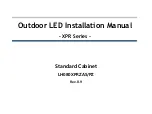
38
Contents
Falcon4 86M Cameras
Gain (PRNU) calibration has a clean, white reference. The quality of this reference is
important for proper calibration. White paper is often not sufficient because the grain in the
white paper will distort the correction. White plastic or white ceramic will lead to better
balancing.
Ambient light flicker (e.g. fluorescent lights) is sufficiently low not to affect camera
performance and calibration results.
The average pixel should be at least 20 % below the target output. If the target is too close,
then some pixels may not be able to reach full swing due to correction applied by the
camera.
When 6.25 % of pixels from a single row within the region of interest are clipped to zero or
max value, flat field correction results may be inaccurate.
Correction results are valid only for the Dark Row Subtract settings for which the coefficients
were calculated. If you change this value, it is recommended that you recalculate your
coefficients.
Appendix D has more details.
An important note on window blemishes
When flat field correction is performed, window cleanliness is paramount. The figure below shows
an example of what can happen if a blemish is present on the sensor window when flat field
correction is performed. The blemish will cast a shadow on the wafer. FFC will compensate for this
shadow by increasing the gain. Essentially FFC will create a white spot to compensate for the dark
spot (shadow). As long as the angle of the incident light remains unchanged then FFC works well.
However when the angle of incidence changes significantly (i.e. when a lens is added) then the
shadow will shift and FFC will makes things worse by not correcting the new shadow (dark spot)
and overcorrecting where the shadow used to be (white spot). While the dark spot can be
potentially cleaned, the white spot is an FFC artifact that can only be corrected by another FFC
calibration.
How to do an FFC Setup in the Camera
In camera flat field calibration can take up to 10 minutes. CamExpert has a default
timeout of 20 seconds per command, which is too short for the FFC calibration to run
fully. You can change the default timeout by setting a command line argument in the
short-cut:
Right click on the short-cut in the start menu and select properties.
Add –timeout 600 to increase the command timeout to 10 minutes (See
below)
Repeat for desktop short-cut
















































